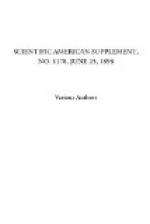The steering gear illustrated below, which has been fitted to a number of vessels in this country as well as on the three North German Lloyd steamers above named, is designed, primarily, to effect the distribution of the leverage more in proportion to the resistance of the rudder than exists in ordinary gears. The latter, as a rule, exert a uniform and decreasing, instead of an increasing, purchase on the rudder, in moving it from midgear to hard over. This important object is attained in the gear under notice chiefly through the arrangement of the quadrant and the spring buffers, which form an essential part of it, and of the tiller crosshead. The quadrant—which, as may be gathered from our illustration, has its main body formed of wrought steel, flanged and riveted, making an exceptionally strong design—works on its own center. It travels through 51 degrees in moving the tiller crosshead through 40 degrees, and in doing so increases the leverage over the rudder to an extent which is equivalent to a gain of 60 per cent. upon midgear position.
[Illustration: Hand gear hard over.]
[Illustration: Hand gear amidships. Croom & ARTHUR’S steering gear.]
Being carried on its own center, and not, as is usual, on the rudder stock, and with its rim supported on rollers, the quadrant does not impose upon the rudder pintles any of its own weight, thus diminishing the wear on these parts. This arrangement also keeps the quadrant always in good gear with its pinion, thereby allowing the teeth of both to be strengthened by shrouding, and rendering them exempt from the effects of sinking and slogger of the rudder stock as the pintles wear. The rack and pinions are of cast steel, as is also the tiller crosshead. The spring buffers, which, as has been said, form an essential part of the quadrant, are fitted with steel rollers at the point of contact with the crosshead, thereby reducing the friction to a minimum. The springs, by their compression, absorb any shock coming on the rudder, and greatly reduce the vibration when struck by a sea. They are made adjustable, and can be either steel or rubber.
Our illustrations show the arrangement of the gear as worked by hand at the rudder head, but of course gears are made having a steam steering engine as the major portion of the arrangement—the two cylinders being placed directly over the quadrant—thus securing the well known advantages attaching to a direct rudder head steering engine as compared with the engine situated amidship, with all the friction of parts, liability to breakage, etc., thereby entailed.
Whether with engine amidship or directly over the rudderhead, ample provision is made for putting the hand power into gear by means of a friction clutch within the standard upon which the hand wheels are mounted. The clutch is of large diameter and lined with hard wood, power and ready facility being provided by the hand lever—seen at the top of standard—and the screw which it operates, for shifting to in and out of gear.




